
Bristol UK Postcards
College Green
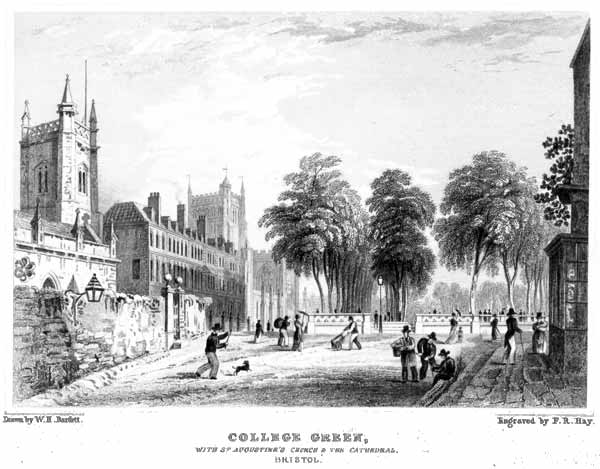
College Green
with St. Augustine's Church and The Cathedral
Bristol
Not a postcard but an old etching, it has the printed text...
Drawn by W. H. Bartlett
Engraved by F. R. Hay
Jones & Co. Temple of the Muses, Finsbury Square, London. Feb 20, 1830
William Henry Bartlett (March 26th, 1809 - September 13th, 1854) was a British artist, best known for his numerous steel engravings. He travelled throughout Britain, and in the mid and late 1840s he travelled extensively in the Balkans and the Middle East. He made four visits to the United States between 1835 and 1852.
From 1778 to 1798 James Lackington, the bookseller, had a shop at No. 32, Finsbury Place South in the southeast corner of Finsbury Square called "The Temple of the Muses". The shop had a frontage of 140 feet and was one of the sights of London. On top of the building was a dome with a flagpole, which flew a flag when Mr. Lackington was in residence. In the middle of the shop was a huge circular counter around which, it was said, a coach and six could have been driven, so large were the premises. A wide staircase led to the "lounging rooms" and the first of a series of galleries with bookshelves. The books became shabbier and cheaper as one ascended. This, the first large book emporium was the pioneer of Remaindering, buying up bulk stock from elsewhere at a bargain price and selling cheap. Every one of the thousands of books in the shop was marked with its lowest price and numbered according to a printed catalogue. In 1792, Lackington estimated his profits for the year to be about £5,000. At this period, he issued more than three thousand catalogues ("A Catalogue of Books, in All Languages, and Classes of Learning, for the Years 1806-7, Now Selling for Ready Money, at the Low Prices Affixed, Warranted Complete, by Lackington, Allen, & Co. Temple of the Muses, Finsbury Square, London.") every year. In 1793 Lackington sold a fourth part of his business to Robert Allen who had been brought up in the shop. The firm of Lackington, Allen and Co. became one of the largest in the book trade, selling upwards of 100,000 volumes yearly at their very extensive premises.
Lackington issued promotional tokens with a facing bust of the proprietor. Th design, which was not particularly successful, yielded place to a more orthodox profile portrait in 1795. The reverse design, used with minor modifications in both years was a figure of Fame blowing a trumpet, proclaiming Lackington's firm the cheapest booksellers in the world. The edges of these tokens usually bore advice as to redemption, on several varieties, payment was guaranteed at the " Temple of the Muses". After Lackington's retirement, his nephew continued the store. Later in the early 1800s the bookstore was sold to Jones and Company for distribution of their books and other works. The shop burned down in 1841.
Source: Georgian Bookshops
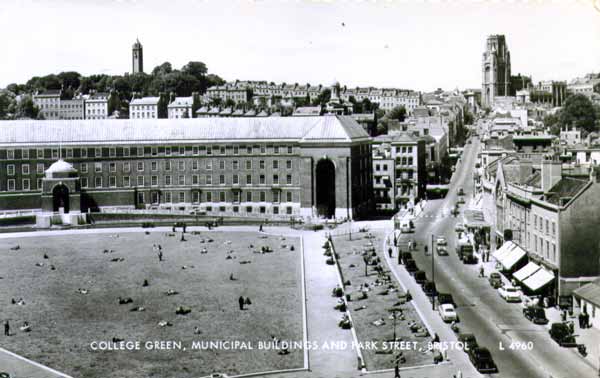
College Green
This unused postcard has the printed text...
L4960
Valentine's
5059 Style
This is a Real Photograph
Printed in Gt. Britain
College Green lies in the heart of the city. Park Street runs north west up the hill away from the green and just to the south, just out of the left hand side of the postcard, is the Cathedral, Central library and Norman Arch. The Council House was designed in the 1930s by Vincent Harris but only built after World War II. In fact, the site had been chosen for the new local government buildings in 1913. The architect was designated in 1933 and work was started by Cowlin and Son in 1938. The war stopped building which was only resumed in 1952. The building was finally opened in 1956. It's probably a good thing the City Council doesn't normally take 43 years to accomplish anything! Atop the Council House are the two gilded unicorns.
On thge right of the postcard can be seen, just behind the shop awnings, St. Marks, the Lord Mayor's Chapel. This building dates from 1230 but is actually all that is left of the Hospital of Gaunt which was founded in 1220 to feed and look after the poor and sick.
At the top of Park Street can be seen the Wills Memorial Tower of the University of Bristol. Officially opened by King George V in 1925, the Wills Tower has been called the last great Gothic building to be constructed in England. It was commissioned and paid for by sons, George Alfred Wills and Henry Herbert Wills, of the first Chancellor of the University, Henry Overton Wills in 1912. It seems unfashionable to mention it nowadays but this is the Wills family of W. D. and H. O. Wills, the giant tobacco company.
The other tower seen in the postcard is Cabot Tower which stands on Brandon Hill. It was built in 1897 in memory of John Cabot, 400 years after he set sail in the Matthew from Bristol and landed in what was later to become Canada. The architect was William Venn Gough. The foundation stone of the tower was laid by the Marquess of Dufferin & Ava on the 24th June, 1897, And the completed tower was opened by the same nobleman on the 6th September, 1898. The 105 ft tall tower consists of a spiral staircase leading to two viewing platforms which overlook the city.
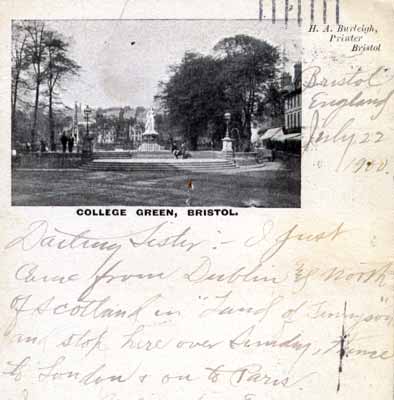
College Green
This postcard, posted in Bristol on July 23rd, 1900, has the printed text...
H. A. Burleigh,
Printer, Bristol
Documents
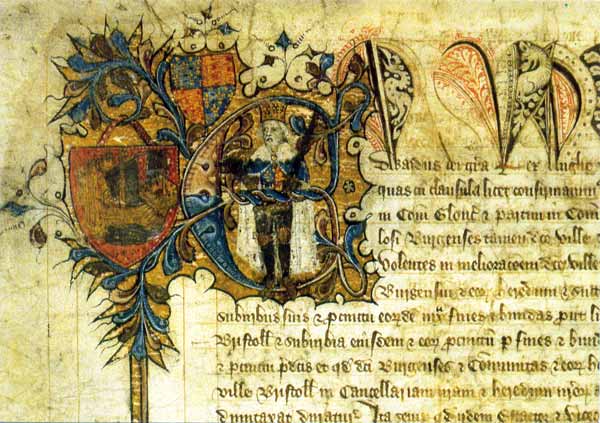
Bristol County Charter
This unused postcard has the printed text...
12315 P&S
Initial Letter of Royal Charter of 8th August 1373
Granting Bristol County Status
Bristol Record Office
Printed by the City of Bristol Printing and Stationary Department
The initial letter contains the Royal Coat of Arms and the Bristol Coat of Arms. Bristol was granted its city charter by Henry II in 1155, in 1373 it ws granted county status by Edward III. Bristol, having always straddled the counties of Somerset and Gloucester was really part of neither, all legal affairs had to conducted in either Ilchester in Somerset or Gloucester. The officials of the town petitioned the King that it become a county in it's own right. Edward III agreed to this a granted the town it's Royal Charter in 1373. The Charter gave the town extensive powers, these included that the Mayor become a royal official and as such have the right to have a sword of state bourne before him. Both he and the Sheriff were entitled to hold courts, thus saving the difficult and expensive trips to Illchester or Gloucester. A council of the 'better and more honest men' was to be elected to assess taxes.
With the issuing of this charter the boundaries and the government of the town was fixed up to the Municipal Reform Act of 1835, 450 years later. The posts of Mayor and Councilors ended up in the hands of the merchants, who tended to fill any vacancies for the various posts with their own nominees. Even so, this Charter was very important to the city and it was with great pride we celebrated the 600th anniversary of the granting of it in 1973.
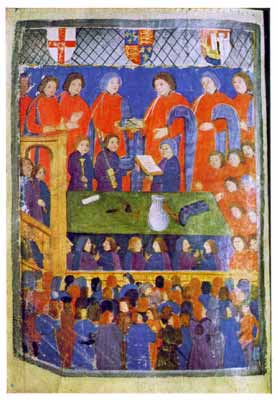
Ricart's Calendar
This unused postcard has the printed text...
Bristol Mayor-making ceremony from
Calendar prepared by Robert Ricart,
Town Clerk in 1479.
Bristol Record Office
Printed by the City of Bristol Printing and Stationary Department
Ricart's Calendar or as it is more commonly spelt, Kalendar, and more properly "The Maire of Bristowe is Kalendar by Robert Ricart", is a thick bound 333 leaf volume that contains many wonderful illustrations such as the one above. Robert Ricart, began this chronicle in 1479, having first recorded the town's history since 1217. He then went on to chronicle the important events of the town over the next three decades. The last entries in Ricart's handwriting were made in 1506, although he appears to have remained Town Clerk until at least 1508. Later town officials then maintained the chronicle until 1898.
Source: Robert Ricart's Chronicle of Bristol, 1480-1508
This page created 20th September 2009, last modified 25th February 2010